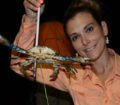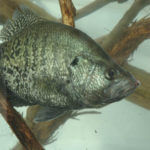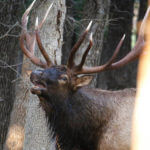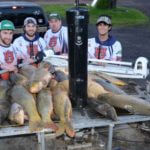John’s Note: The last weekend in June, 2016, I went bowfishing with Jill Zednick, a marine biologist for the State of Mississippi, and Josh Delancey, a welding inspector, in Biloxi, Mississippi, with Mike Moore of the “Strictly Business” charter boat. Zednick and Delancey they now hold three state and world records for bowfishing. Zednick only started bowfishing in April, 2015, and Delancey just set a new World’s Record for taking cobia – a 41.7-pounder – with his bow on June 22, 2016.
 Tidal rivers feed the marshes and the back bays all along the Mississippi Gulf Coast and the entire Upper Gulf Coast. To take saltwater and brackish-water fish like flounder, sheepshead and redfish, the higher the salinity in the water, the more of these fish you’ll find in the back bays and tidal rivers. Also, the tide impacts when to bowfish the back bays for some of the tastier saltwater species. One of the key ingredients is to watch the weather. If there’s been a lot of rain upstream of the coastal rivers a day or two before you’re bowfishing, more than likely that rain will cause a volume of fresh water to come down the rivers and push the salt water out of the back bays. However, if the river’s down, and there hasn’t been rain in a while, the salt water will begin to move further into the back bays, tidal rivers and estuary areas. As the water becomes saltier, flounder, redfish, black drum, sheepshead, mullet and crabs will move into the marshes, back bays and estuaries, and that’s when fishing in the bays really gets good.
Tidal rivers feed the marshes and the back bays all along the Mississippi Gulf Coast and the entire Upper Gulf Coast. To take saltwater and brackish-water fish like flounder, sheepshead and redfish, the higher the salinity in the water, the more of these fish you’ll find in the back bays and tidal rivers. Also, the tide impacts when to bowfish the back bays for some of the tastier saltwater species. One of the key ingredients is to watch the weather. If there’s been a lot of rain upstream of the coastal rivers a day or two before you’re bowfishing, more than likely that rain will cause a volume of fresh water to come down the rivers and push the salt water out of the back bays. However, if the river’s down, and there hasn’t been rain in a while, the salt water will begin to move further into the back bays, tidal rivers and estuary areas. As the water becomes saltier, flounder, redfish, black drum, sheepshead, mullet and crabs will move into the marshes, back bays and estuaries, and that’s when fishing in the bays really gets good.
 Although most bowfishermen prefer to fish a falling tide, as long as you have a tide either coming in or going out, saltwater fish will feed. On an outgoing tide, bull minnows, bait fish, small crabs and snails all will have to come out of the grass marshes as the water moves out; and that’s where the sportfish like flounder, sheepshead, black drum and redfish will be waiting to ambush the bait going out of the grass. On an incoming tide, the bait fish will be moving toward the grass, and the prey fish will set-up on the edge of the grass, waiting on the bait fish to come from deeper water and move back into the grass. Wherever you locate the bait fish is where you’ll discover the sportfish you want to take. That’s the reason back bays, coastal rivers and estuary areas where bait fish, shrimp and small crustaceans hide out make for great bowfishing!
Although most bowfishermen prefer to fish a falling tide, as long as you have a tide either coming in or going out, saltwater fish will feed. On an outgoing tide, bull minnows, bait fish, small crabs and snails all will have to come out of the grass marshes as the water moves out; and that’s where the sportfish like flounder, sheepshead, black drum and redfish will be waiting to ambush the bait going out of the grass. On an incoming tide, the bait fish will be moving toward the grass, and the prey fish will set-up on the edge of the grass, waiting on the bait fish to come from deeper water and move back into the grass. Wherever you locate the bait fish is where you’ll discover the sportfish you want to take. That’s the reason back bays, coastal rivers and estuary areas where bait fish, shrimp and small crustaceans hide out make for great bowfishing!
To learn more about saltwater fishing, check out “Alabama’s Inshore Saltwater Fishing: A Year-Round Guide for Catching More Than 15 Species,” “Alabama’s Offshore Saltwater Fishing: A Year-Round Guide for Catching Over 15 Species of Fish,” “Fishing Mississippi’s Gulf Coast and Visitor’s Guide,” “How to Fish Mississippi’s Gulf Coast in June” and “13 Saltwater Fish Recipes You Can’t Live Without,” available in Kindle eBooks and some print books.
















